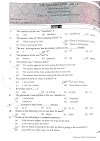Gaseous discharge
Gaseous discharge is phenomenon of discharge of gas by reducing pressure to very low value.
A gas is insulator at normal temperature and pressure.
A gas can be made conducting by
I. Applying very high voltage.
II. Reducing pressure of a gas to very low value.
Results of pressure in discharge tube experiment:
Pressure Inside Tube Result Normal pressure No discharge(gas acts as insulator) 10 mm of Hg Zig zag thin blue streamers with cracking space 5 mm of Hg Zig zag thick luminous column(Geissler's discharge) 2 mm of Hg Luminous positive column from cathode to anode 1 mm of Hg Faraday's dark space between positive column and negative glow 0.5 mm of Hg Crooke's dark space between cathode glow and negative glow 0.05 mm of Hg Breaking of positive column into striations 0.01 mm of Hg Cathode rays travel from cathode to anode 0.0001 mm of Hg Discharge vaishes
Cathode rays
Discovered by Sir William Crookes.
Cathode rays are stream of fast moving electrons.
They are not electromagnetic wave.
They are deflected in electric and magnetic field.
The can travel with speed ranging to velocity of light.
They ionize the gas through which they pass.
They produce florescence and can affect photographic plate.
They possess both momentum and kinetic energy and can exert mechanical pressure.
They produce heat on falling on metal surface.
They can penetrate thin foils of metal but produces x-rays on striking metal of high melting point and high atomic weight.
Positive rays
Discovered by Eugen Goldstein.
These are streams of positive ions which are moving towards the cathode in discharge tube.
They are deflected by electric and magnetic field.
They are produced at different places in the discharge tube. As they are produced at different places in discharge tube, they are accelerated to different intervals of time in the electric field. Hence, they acquire different velocities.
Their velocity is much less than that of cathode rays as they are heave.
They ionize the gas through which they pass and their ionizing power is more than that of cathode rays.
J.J. Thomson’s experiment
It was conducted by Joseph John Thomson in 1897 A.D.
Operating principle: When the electron is projected in cross field, it passes undeviated.
Note: When an electron is projected in cross field (E perpendicular B), it passes undeviated and velocity of electron ,
The result of this experiment is determination of specific charge of electron i.e.
Specific charge of electron is .
When an electron beam is accelerated from cathode to anode, it loses its potential energy in gaining kinetic energy at anode. i.e.
Millikan’s oil drop experiment
It was conducted by Robert Andrews Millikan in 1909 A.D.
It is used to determine charge of an electron.
It is strong evidence of quantization of charge.
It is based on Stoke’s law of viscosity.
Note:
I. For stationary drop in electric field,
II. For oil drop falling downwards with terminal velocity ‘’,
The charge of an electron is elementary charge and was found to be
.
Effect of electric field on charge
When a charged particle having charge ‘’ of mass ‘’ moving with velocity ‘’ is subjected to a uniform electric field ‘’
I. Force experienced by particle
II. The path of particle is straight line, when its velocity is parallel or antiparallel to electric field.
III. The path of particle is parabolic, when angle between velocity and electric field is other than and .
IV. The displacement of the charged particle parallel to which is perpendicular to initial direction of motion of particle while entering the electric field is
, where is distance through which electric field is acting.
Effect of magnetic field on charge
When a charged particle having charge ‘’ of mass ‘’ moving with velocity ‘’ is subjected to a uniform magnetic field ‘’
I. Force experienced by particle
II. The direction of is perpendicular to as well as .
III. The path of particle is straight line, when its velocity is parallel or antiparallel to magnetic field.
IV. The path of particle is helical/spiral, when angle between velocity and electric field is other than , and .
V. The path of particle is circular, when angle between velocity and electric field is .
VI. The displacement of the charged particle due to magnetic field is , where is distance through which magnetic field is acting.
VII. If is perpendicular to , then (maximum force). Then the particle will describe a circular path of radius r, given my i.e.
VIII. The speed, magnitude of momentum and of particle does not change while moving through magnetic field.
IX. If is parallel or antiparallel to , the force on particle is zero and velocity of particle remains unchanged.









0 Comments